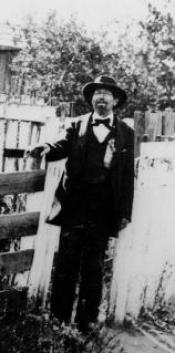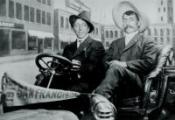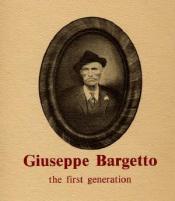Two Streets and a Bridge
by Carolyn Swift, Director, Capitola Historical Museum
Much like small towns everywhere, Soquel gave its first streets and landmarks the names of early settlers, many of whom have descendants who have lived locally for generations. Acknowledging this tradition, Mark Szychowski lightheartedly introduced the three speakers at the Soquel Library's Pioneer Family Night on September 18, 2002, as "two streets and a bridge."
Alice Daubenbis, Michael Ponza and Peter Bargetto told about the families of John Daubenbiss and his brother Henry, who dropped one "s" from his surname; the Ponza brothers, who gave title to Ponza Lane; and Giuseppe Bargetto's sons, John and Phillip, who established the Bargetto Winery.

Daubenbis, noting that her family was known for "a house, a street and a bus stop," explained how her pioneering ancestor arrived in New York from Europe as a teenager in 1835 and made it all the way to California by 1843. Hired by Mariano Vallejo to construct a mill at San Jose, John Daubenbiss put down his tools to join with the Mexican Army under Governor Micheltorena in the fight against Spain. He was naturalized a Mexican citizen in 1844 but joined the Fremont Battalion a year later in support of California's attempt to overthrow Mexican rule.
Daubenbiss and John Hames teamed up in Soquel to build a sawmill for Martina Castro and her husband, Michael Lodge. The following summer, Fremont recruited both mill builders to support the seizure of California for the United States.
When the skirmishes were over, Daubenbiss headed back to Soquel, bought a section of the Rancho Arroyo del Rodeo, married sweetheart Sarah Lard and settled down to the life of a western farmer. Alice Daubenbis traced her direct line to great-great grandfather Henry, who immigrated in 1853 and took a job in one of his brother's Soquel mills. Daubenbis married Margaret Gamar and raised seven children, served several terms on the Soquel School Board and ten years as a Santa Cruz County supervisor.

While the Daubenbiss family came from Bavaria, the Ponzas and Bargettos both emigrated from the Piedmonte region of Italy.
Michael Ponza's grandfather, Lorenzo, had set out for America from Vilafalletto, near the French border, in 1900.
"He was the oldest of the four sons of Giovanni Ponza," he said. "The economy in Italy was bad at the time. As a teenager, he walked from Piedmonte to France to work summers during harvest time. He did this until he had enough money to come to America-that was his dream."
Lorenzo first worked in the fields of the San Joaquin Valley but soon moved on to jobs in the sawmills of the coast, putting money aside until he could pay passage to America for brothers Michael, Giorgio and Antonio.

By 1915, they were all together at Glenwood, felling sections of first-growth redwood and cutting split stuff for vineyard pickets and cattle poles. The Gallo family used the pickets for their first vineyards in Modesto.
"After a fire, the brothers had to regroup," continued Ponza, "and, about that time, World War I was going on. Michele, the one I'm named after, decided to go to Italy, which was on America's side at the time. He had horrible luck. Mike was gassed and taken prisoner by the Austrians. The war was about ended before he was able to get away and back to Italy."
Another brother met a worse fate at home. Giorgio was infected by a redwood sliver that led to blood poisoning. He was taken to San Jose and had his finger amputated in time but died of pneumonia two days later. Mike's father, youngest son Antonio, was lucky. Serving with the American Army at Fort Lewis, Washington, he was assigned duty cutting spruce trees for aircraft construction.
"It was one of those times when they actually put someone to work doing a job he knew how to do," Ponza laughed.
Antonio bought the land at Rodeo Gulch before the Depression, and struggled through it, at times barely able to make interest payments on the ranch. He cleared the brush and planted a vineyard, acres of cherries, pears and apples in addition to 20 acres of apricots already existing on the ranch.
"I have my home there, and I planted some apples," said the son. "But there is a big difference from how it was then. Now the deer, gophers and the birds clean up everything."
Peter Bargetto, who was in the midst of wine crushing, took time away from work to tell how the Bargettos started producing wines in Soquel. He traced family roots to great-grandfather Giuseppe Bargetto, a winemaker near Asti in Italy, who came to America in 1887. His sons, Phillip and John, began making wines in California, moved to Soquel and started a produce business and then, after Prohibition, established the winery. John's sons, Lawrence and Ralph Bargetto, later took charge as co-partners through the 1960s, until Ralph decided to start a business in real estate.
Bargetto Bridge in Soquel Village is named for Peter's uncle, Lawrence, who supervised the winemaking operation until his death in 1982. Several years ago, two of Ralph's sons, Peter and his brother, Paul, bought a piece of their grandfather's original estate off Glen Haven Road, where Soquel Vineyards is now expanding the family winemaking tradition.
